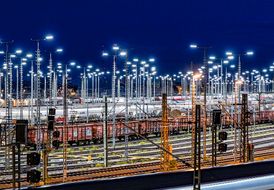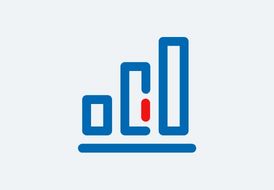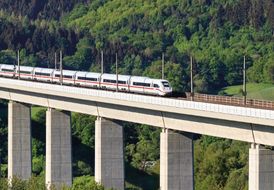New digitalization projects and concepts
Artificial intelligence in rail operations
- AI supports the dispatchers on the S-Bahn (metro) Stuttgart in controlling traffic as efficiently as possible in the event of a disruption. This helps improve punctuality and relieves the strain on busy routes. The AI tool was developed in-house and is being gradually rolled out on other S-Bahn (metro) networks.
- In maintenance, we use AI to visually identify damage to ICEs. This technology will be used in several ICE depots in the future. The project has also been expanded to include regional transport and freight trains.
Digital Rail for Germany (Digitale Schiene Deutschland; DSD)
Our target is to offer more attractive rail transport with more capacity of a higher quality, without the need for additional tracks. We will do this with the creation of a digital platform for the rail system, and by equipping the system with digital interlockingsno. 145 and the European Train Control System (ETCS). This platform will then be used to operate new technologies to enable the rail operations of the future.
After reaching a consensus on the implementation of the Digital Rail for Germany program with the Federal Railway Authority (Eisenbahn-Bundesamt; EBA) and the German Railway Industry Association (Verband der Bahnindustrie; VDB), followed by the signing of a letter of intent in September 2020, we are on the way to speeding up the rollout of Digital Rail for Germany. As a result, the network can be fully equipped with digital command and control technology by 2035. In addition to securing financing (for infrastructure and vehicle equipment), this will require, among other things, series-ready technology, optimized processes for planning, implementation and commissioning, sufficient radio capacity and the securing of personnel resources. Implementation is discussed in five regular working groups together with the Federal Government and the sector players, as part of a Digital Rail for Germany project.
As part of the 2020 launch package, the concrete planning and installation of ETCS and digital interlockings has begun in the context of the Stuttgart Digital Hub (Digitaler Knoten Stuttgart; DKS), the Cologne — Rhine/Main high-speed line and the accessibility of the Trans-European Scandinavia — Mediterranean corridor. Stuttgart will be the first region in Germany to receive the digital train control and interlock-ing technology. In early 2021, the BMDV published a vehicle funding directive for the corresponding refitting of the relevant vehicles in the Stuttgart Digital Hub, and made funds available in the budget.
In order to accelerate the switch to digital interlockings, the Federal Government provided additional funds for a fast-track program, amounting to€ 500 million by the end of 2021. In a total of seven projects, the existing signaling and level crossing security technology will be replaced by modern and digital interlocking elements. This program will be used for developing and testing new processes and technologies together with the railway industry in order to equip the network comprehensively with digital interlockings.
Key milestones have also been reached in the digitalization of the rail system:
- As part of the “Digital S-Bahn (metro) Hamburg” pilot project, highly automated rail operations based on Automatic Train Operation (ATO) and ETCS were demonstrated at the ITS World Congress in October 2021. Four existing vehicles on the Hamburg S-Bahn (metro) network were equipped with digital technology, and 23 km of track were upgraded. In addition, the fully automated shunting process was demonstrated at the ITS World Congress at Bergedorf station in Hamburg. Training and qualifications are also being run for additional train drivers. The ATO and ETCS journeys are scheduled to start in daily passenger operations from April 2022.
- Together with our project partners Siemens Mobility, Bosch Engineering, ibeo automotive and HERE Technologies, we have equipped another S-Bahn (metro) Hamburg train with state-of-the-art sensors as part of our joint project Sensors4Rail. The 14 sensors record information about the train environment using the radar, lidar and camera systems. The sensor information can be matched with a digital map to precisely position the vehicle. In future, based on this data, trains will be able to be controlled optimally and run at shorter intervals. This should allow an increase in network capacity. At the ITS World Congress, the Sensors4Rail project was put to the test for the first time on the S 21 S-Bahn (metro) line between Bergedorf and Hamburg Dammtor stations. From 2022 to 2023, we will continue testing the technology in continuous operations. Data will be collected and scenario tests will be carried out to improve the (AI-based) functions.
- At the “Digital Rail Test Site” in the Erzgebirge region, switches and signals for the Erzgebirgsbahn are already being provided digitally in the Annaberg — Buchholz section. This is complemented by the expansion of a 5G test network along the Markersbach — Schlettau section. In 2021, the development of a research environment with eight 5G radio masts along the line was completed and commissioned. In addition, various innovative technologies relating to the new Future Railway Mobile Communication System (FRMCS)/5G standard were tested for use in operation. For example, innovative antenna technologies for the railway network of the future were tested together with Ericsson and Rohde&Schwarz. Findings from the tests serve to optimize radio network planning with regard to future digital rail applications.
New agreement on digital cooperation
Four years after the start of the digitalization cooperation program between the French state-owned railway SNCF and DB Group, further steps were agreed to push ahead with the automation of rail operations and to increase the quality, performance and attractiveness of rail transport. The cooperation program also focuses on energy management and reducing carbon emissions. The aim is to speed up the integration of new solutions and to meet the requirements of the European Green Deal.
WiFi@DB
We have launched a new WiFi@DB WiFi network as part our free Internet service. Over 141 stations, all DB lounges, the entire ICE fleet, and the first regional trains and buses are already connected. We are continuously expanding our WiFi infrastructure.
High-speed Internet access for digital rail transport
We are working with partners to develop innovative cables for expanding our fiber-optic network. These cables are resistant to external influences, can be installed quickly and easily and can be laid directly in the earth. This reduces the number of construction sites and avoids additional line closures. The new fiber-optic cables will first be used on the Odenwald railway.



